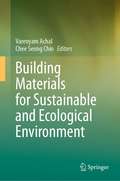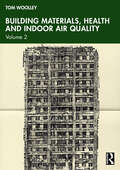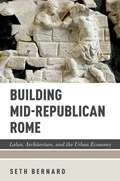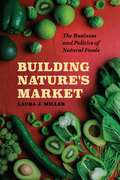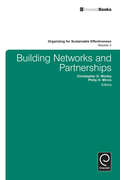- Table View
- List View
Building Lean, Building BIM: Improving Construction the Tidhar Way
by Rafael Sacks Samuel Korb Ronen BarakBuilding Lean, Building BIM is the essential guide for any construction company that wants to implement Lean Construction and Building Information Modelling (BIM) to gain a strategic edge over their competition. The first of its kind, the book outlines the principles of Lean, the functionality of BIM, and the interactions between the two, illustrating them through the story of how Tidhar Construction has implemented Lean Construction and BIM in a concerted effort over four years. Tidhar is a small-to-medium-sized construction company that pioneered a way of working that gave it a profit margin unheard of in its market. The company's story serves as a case study for explanation of the various facets of Lean Construction and BIM. Each chapter defines a principle of Lean and/or BIM, describes the achievements and failures in Tidhar's implementation based on the experiences of the key people involved, and reviews the relevant background and theory. The implementation at Tidhar has not been a pure success, but by examining their motives alongside their achievements and failures, readers will learn about what pitfalls and pinnacles to expect. A number of chapters also compare the experience of Tidhar with those of other companies who are leaders in their fields, such as Skanska and DPR. This book is highly relevant and useful to a wide range of readers from the construction industry, especially those who are frustrated with the inefficiencies in their companies and construction projects. It is also essential reading for Lean and BIM enthusiasts, researchers and students from a variety of industries and backgrounds.
Building Learning Experiences in a Changing World (Advances in Business Education and Training #3)
by Piet Van den Bossche, Wim H. Gijselaers and Richard G. MilterAdvances in Business Education & Training is a Book Series to foster advancement in the field of Business Education and Training. It serves as an international forum for scholarly and state-of-the-art research and development into all aspects of Business Education and Training. This new volume deals with several aspects of the challenge to design learning in and for a changing world. The first part concerns program development. How to build curricula that are future-proof? Principles to innovate our curricula are identified. It answers the question how we can incorporate the need for change in our thinking about curriculum-development and identify the necessary elements to incorporate in our curricula. The second part focuses on the increasing diversity of students and employees within our schools and organizations, in terms of culture, language, and perception of ability, gifts, and talents. This offers a range of opportunities, but at the same time can possibly jeopardize some processes that are taken for granted. Chapters in this part analyze the processes that play a crucial role in dealing with this diversity and identify educational practices that can help to harvest the potential that lies within this diversity. The third part of this book digs further into the possibilities that are opened up by the implementation of ICT-support in our learning environments. E-learning provides tools to adapt these environments to the needs of an increasingly diverse student-population. In the last part we focus specifically on the workplace and how learning can be designed in such a way that employees are equipped for a shifting workplace. On the one hand it is looked how training can affect performance in the workplace. Does learning transfer to the work environment? On the other hand it is questioned how one can design affordances to trigger learning in the workplace.
Building Leverage and Capacity: The Challenge of Growth (Wiley Global Finance Executive Select #147)
by Mark C. Tibergien Rebecca PomeringOne of the most important strategies for a successful investment advisory or wealth management firm is how to manage growth and profits. Once an advisory firm begins to add any staff, it has started to accelerate its growth. It will need to monitor and measure performance, coach and counsel people, produce an increasing amount of revenue to cover the added overhead, and invest in more technology solutions, office space, and employee benefits. Author Mark Tibergien, named by Investment Advisor as one of the most influential people in the industry, provides a comprehensive analysis of: Managing the rising costs of an advisory firm Management and quality control Client satisfaction Training staff Filled with models, statistics, and case studies, this chapter from Practice Made Perfect looks at the client-service approach, infrastructure, and compensation techniques necessary for an advisory firm to grow into an elite practice.
Building Markets for Knowledge Resources: Emerging Pervasive Models of Innovation in Practice
by Maria Rosaria Della PerutaPeruta examines emerging pervasive models of innovation and how their nature, effects, and origins are characterized. The book starts with the definition of markets for knowledge resources and analyses the integration of market players (e.g. suppliers, customers, competitors, laboratories and research institute) such as the fundamental prerequisite for promoting the development of the new era of open innovation. By focusing on different organizational models and considering both mechanisms pecuniary and non-pecuniary, the book aims to compare the theoretical assumptions and the managerial implications of the emerging open business models with the traditional closed innovation ones. The open business models are characterized essentially by the fact of encouraging innovation as part of the interactive co-creation process outside the boundaries of the firm.
Building Materials for Sustainable and Ecological Environment
by Varenyam Achal Chee Seong ChinThis book uses theories, hypotheses, policies, practical insights and case studies to introduce and elucidate green building materials for sustainable construction. Cement is the most widely used building material in construction; however, it is not sustainable, being responsible for 7% of global carbon dioxide emissions and consuming huge quantities of energy. In order to limit the ecological damage, sustainable building materials are needed. Ecosystems are a source of important lessons and models for transitioning the built environment onto a sustainable path that opens options for sustainable building material in construction. The book provides a guide for readers seeking knowledge on sustainable building materials with the potential to lower environmental impact by reducing CO2 emission throughout the building’s lifecycle. The book is motivated by recent rapid advances in sustainable building materials production, including green building materials made of industrial by-products and recycled wastes, earth materials, plant-based materials, microbial-based materials or supplementary cementitious materials, to reduce the environmental impacts of traditional building materials. Discussing the development and applications of various sustainable building materials, including related case studies, and addressing the environmental issue with a holistic and systematic approach that creates an ecology of construction for sustainability in infrastructures, it offers promising solutions to achieve renewable and sustainable building materials for the future.
Building Materials, Health and Indoor Air Quality: Volume 2
by Tom WoolleyIn Building Materials, Health and Indoor Air Quality: Volume 2 Tom Woolley uses new research to continue to advocate for limiting the use of hazardous materials in construction and raise awareness of the links between pollutants found in building materials, poor indoor air quality and health problems. Chapters in this volume reinforce previous arguments and present new ones covering: Further evidence of the health impacts of hazardous emissions from materials Hazardous materials to be avoided and why Fire and smoke toxicity – the Lakanal House and Grenfell Tower legacy Sub-standard retrofits leading to damp and mould in previously sound houses A critical review of recent reports from UK Government and others on air quality and health problems including policy changes on flame retardants Growing evidence of cancer risks and the failure of cancer research organisations to address these issues A critical review of recent climate change and zero carbon policies and a discussion on whether extreme energy efficiency is a good thing This book asks some important and, for some, uncomfortable questions, but in doing so it brings to light important areas for research and provides much needed guidance for architects, engineers, construction professionals, students and researchers on hazardous materials and how to reduce their use and design and build healthier buildings for all occupants.
Building Materials, Health and Indoor Air Quality: Volume 2
by Tom WoolleyIn Building Materials, Health and Indoor Air Quality: Volume 2 Tom Woolley uses new research to continue to advocate for limiting the use of hazardous materials in construction and raise awareness of the links between pollutants found in building materials, poor indoor air quality and health problems. Chapters in this volume reinforce previous arguments and present new ones covering: Further evidence of the health impacts of hazardous emissions from materials Hazardous materials to be avoided and why Fire and smoke toxicity – the Lakanal House and Grenfell Tower legacy Sub-standard retrofits leading to damp and mould in previously sound houses A critical review of recent reports from UK Government and others on air quality and health problems including policy changes on flame retardants Growing evidence of cancer risks and the failure of cancer research organisations to address these issues A critical review of recent climate change and zero carbon policies and a discussion on whether extreme energy efficiency is a good thing This book asks some important and, for some, uncomfortable questions, but in doing so it brings to light important areas for research and provides much needed guidance for architects, engineers, construction professionals, students and researchers on hazardous materials and how to reduce their use and design and build healthier buildings for all occupants.
Building Materials, Health and Indoor Air Quality: Volume 2
by Tom WoolleyIn Building Materials, Health and Indoor Air Quality: Volume 2 Tom Woolley uses new research to continue to advocate for limiting the use of hazardous materials in construction and raise awareness of the links between pollutants found in building materials, poor indoor air quality and health problems. Chapters in this volume reinforce previous arguments and present new ones covering: Further evidence of the health impacts of hazardous emissions from materials Hazardous materials to be avoided and why Fire and smoke toxicity – the Lakanal House and Grenfell Tower legacy Sub-standard retrofits leading to damp and mould in previously sound houses A critical review of recent reports from UK Government and others on air quality and health problems including policy changes on flame retardants Growing evidence of cancer risks and the failure of cancer research organisations to address these issues A critical review of recent climate change and zero carbon policies and a discussion on whether extreme energy efficiency is a good thing This book asks some important and, for some, uncomfortable questions, but in doing so it brings to light important areas for research and provides much needed guidance for architects, engineers, construction professionals, students and researchers on hazardous materials and how to reduce their use and design and build healthier buildings for all occupants.
Building Materials, Health and Indoor Air Quality: Volume 2
by Tom WoolleyIn Building Materials, Health and Indoor Air Quality: Volume 2 Tom Woolley uses new research to continue to advocate for limiting the use of hazardous materials in construction and raise awareness of the links between pollutants found in building materials, poor indoor air quality and health problems. Chapters in this volume reinforce previous arguments and present new ones covering: Further evidence of the health impacts of hazardous emissions from materials Hazardous materials to be avoided and why Fire and smoke toxicity – the Lakanal House and Grenfell Tower legacy Sub-standard retrofits leading to damp and mould in previously sound houses A critical review of recent reports from UK Government and others on air quality and health problems including policy changes on flame retardants Growing evidence of cancer risks and the failure of cancer research organisations to address these issues A critical review of recent climate change and zero carbon policies and a discussion on whether extreme energy efficiency is a good thing This book asks some important and, for some, uncomfortable questions, but in doing so it brings to light important areas for research and provides much needed guidance for architects, engineers, construction professionals, students and researchers on hazardous materials and how to reduce their use and design and build healthier buildings for all occupants.
Building Methodological Bridges (Research Methodology in Strategy and Management #6)
by Donald D. Bergh David J. Ketchen Jr.This book series' mission is to provide a forum for critique, commentary, and discussion about key research methodology issues in the strategic management field. Strategic management relies on an array of complex methods drawn from various allied disciplines to examine how managers attempt to lead their firms toward success. With this in mind this sixth volume of the series is built around the theme of 'Building methodological bridges'. Within this overarching theme, this volume includes two subthemes. The first is 'Bridges between macro and micro research' and the second is 'Bridges to stronger designs and analysis'. With authors from an array of backgrounds, including thought leaders from not only strategic management, but also from organizational behavior, human resource management, and entrepreneurship, we are confident that the chapters offered in the current volume will build bridges for the organizational sciences toward greater methodological rigor and creativity.
Building Mid-Republican Rome: Labor, Architecture, and the Urban Economy
by Seth BernardBuilding Mid-Republican Rome offers a holistic treatment of the development of the Mid-Republican city from 396 to 168 BCE. As Romans established imperial control over Italy and beyond, the city itself radically transformed from an ambitious central Italian settlement into the capital of the Mediterranean world. Seth Bernard describes this transformation in terms of both new urban architecture, much of it unprecedented in form and extent, and new socioeconomic structures, including slavery, coinage, and market-exchange. These physical and historical developments were closely linked: building the Republican city was expensive, and meeting such costs had significant implications for urban society. Building Mid-Republican Rome brings both architectural and socioeconomic developments into a single account of urban change. Bernard, a specialist in the period's history and archaeology, assembles a wide array of evidence, from literary sources to coins, epigraphy, and especially archaeological remains, revealing the period's importance for the decline of the Roman state's reliance on obligation and dependency and the rise of slavery and an urban labor market. This narrative is told through an investigation of the evolving institutional frameworks shaping the organization of public construction. A quantitative model of the costs of the Republican city walls reconstructs their economic impact. A new account of building technology in the period allows for a better understanding of the social and demographic profile of the city's builders. Building Mid-Republican Rome thus provides an innovative synthesis of a major Western city's spatial and historical aspects, shedding much-needed light on a seminal period in Rome's development.
Building Models for Marketing Decisions (International Series in Quantitative Marketing #9)
by Peter S.H. Leeflang Dick R. Wittink Michel Wedel Philippe A. NaertThis book is about marketing models and the process of model building. Our primary focus is on models that can be used by managers to support marketing decisions. It has long been known that simple models usually outperform judgments in predicting outcomes in a wide variety of contexts. For example, models of judgments tend to provide better forecasts of the outcomes than the judgments themselves (because the model eliminates the noise in judgments). And since judgments never fully reflect the complexities of the many forces that influence outcomes, it is easy to see why models of actual outcomes should be very attractive to (marketing) decision makers. Thus, appropriately constructed models can provide insights about structural relations between marketing variables. Since models explicate the relations, both the process of model building and the model that ultimately results can improve the quality of marketing decisions. Managers often use rules of thumb for decisions. For example, a brand manager will have defined a specific set of alternative brands as the competitive set within a product category. Usually this set is based on perceived similarities in brand characteristics, advertising messages, etc. If a new marketing initiative occurs for one of the other brands, the brand manager will have a strong inclination to react. The reaction is partly based on the manager's desire to maintain some competitive parity in the mar keting variables.
Building Moonshots: 50+ Ways To Turn Radical Ideas Into Reality
by Tamara Carleton William CockayneSolve the world’s biggest problems and create a better future In Building Moonshots: 50+ Ways to To Turn Radical Ideas Into Reality, a team of expert innovation strategists delivers an exciting and insightful collection of strategies, techniques, and frameworks for scaling your next big, audacious idea into a concrete product or service. Each proven and tested strategy contained in the book has been categorized to make it easy to find and implement when you need it most. You’ll learn how and where to start, when to bet big, how to invest, when to play the long game, what to communicate, and much more. You’ll also find: Ways to go beyond white papers and vision statements to a place where your ideas become a tangible reality Strategies for creating a better future by transforming seemingly impossible ideas into concrete products Methods for bringing to life radical and innovative solutions to the world’s greatest challengesDestined to become the seminal, go-to source for visionaries, gamechangers, and leaders imagining the apparently impossible and determined to achieve it, Building Moonshots is a can’t-miss book for entrepreneurs, founders, product development heads, and other business leaders.
Building Moonshots: 50+ Ways To Turn Radical Ideas Into Reality
by Tamara Carleton William CockayneSolve the world’s biggest problems and create a better future In Building Moonshots: 50+ Ways to To Turn Radical Ideas Into Reality, a team of expert innovation strategists delivers an exciting and insightful collection of strategies, techniques, and frameworks for scaling your next big, audacious idea into a concrete product or service. Each proven and tested strategy contained in the book has been categorized to make it easy to find and implement when you need it most. You’ll learn how and where to start, when to bet big, how to invest, when to play the long game, what to communicate, and much more. You’ll also find: Ways to go beyond white papers and vision statements to a place where your ideas become a tangible reality Strategies for creating a better future by transforming seemingly impossible ideas into concrete products Methods for bringing to life radical and innovative solutions to the world’s greatest challengesDestined to become the seminal, go-to source for visionaries, gamechangers, and leaders imagining the apparently impossible and determined to achieve it, Building Moonshots is a can’t-miss book for entrepreneurs, founders, product development heads, and other business leaders.
Building More Effective Unions
by Paul F. ClarkEmployers have long turned to behavioral science for guidance on making their organizations more effective. Labor scholar Paul F. Clark believes union leaders should also take advantage of the valuable discoveries made in this field, and he offers a straightforward account of how they can do so.Much of the behavioral science research relevant to unions relies on complex statistical analyses and is disseminated through scholarly journals. This clearly written book makes the findings of behavioral science accessible to those committed to building a stronger labor movement. It describes behavioral science's understanding of such topics as organizational commitment and member participation and suggests how this knowledge can best be applied to unions.Building More Effective Unions offers practical strategies unions can use to their advantage in a number of areas, including:-Union participation-Organization and retention -Union orientation and socialization-Political action-Grievance procedures-Information and communications -Union image-building-Union culture-Union leadershipThe book features examples of how unions and their leaders have benefited from putting the principles of behavioral science into practice.
Building Nature's Market: The Business and Politics of Natural Foods
by Laura J. MillerFor the first 150 years of their existence, “natural foods” were consumed primarily by body builders, hippies, religious sects, and believers in nature cure. And those consumers were dismissed by the medical establishment and food producers as kooks, faddists, and dangerous quacks. In the 1980s, broader support for natural foods took hold and the past fifteen years have seen an explosion—everything from healthy-eating superstores to mainstream institutions like hospitals, schools, and workplace cafeterias advertising their fresh-from-the-garden ingredients. Building Nature’s Market shows how the meaning of natural foods was transformed as they changed from a culturally marginal, religiously inspired set of ideas and practices valorizing asceticism to a bohemian lifestyle to a mainstream consumer choice. Laura J. Miller argues that the key to understanding this transformation is to recognize the leadership of the natural foods industry. Rather than a simple tale of cooptation by market forces, Miller contends the participation of business interests encouraged the natural foods movement to be guided by a radical skepticism of established cultural authority. She challenges assumptions that private enterprise is always aligned with social elites, instead arguing that profit-minded entities can make common cause with and even lead citizens in advocating for broad-based social and cultural change.
Building Nature's Market: The Business and Politics of Natural Foods
by Laura J. MillerFor the first 150 years of their existence, “natural foods” were consumed primarily by body builders, hippies, religious sects, and believers in nature cure. And those consumers were dismissed by the medical establishment and food producers as kooks, faddists, and dangerous quacks. In the 1980s, broader support for natural foods took hold and the past fifteen years have seen an explosion—everything from healthy-eating superstores to mainstream institutions like hospitals, schools, and workplace cafeterias advertising their fresh-from-the-garden ingredients. Building Nature’s Market shows how the meaning of natural foods was transformed as they changed from a culturally marginal, religiously inspired set of ideas and practices valorizing asceticism to a bohemian lifestyle to a mainstream consumer choice. Laura J. Miller argues that the key to understanding this transformation is to recognize the leadership of the natural foods industry. Rather than a simple tale of cooptation by market forces, Miller contends the participation of business interests encouraged the natural foods movement to be guided by a radical skepticism of established cultural authority. She challenges assumptions that private enterprise is always aligned with social elites, instead arguing that profit-minded entities can make common cause with and even lead citizens in advocating for broad-based social and cultural change.
Building Nature's Market: The Business and Politics of Natural Foods
by Laura J. MillerFor the first 150 years of their existence, “natural foods” were consumed primarily by body builders, hippies, religious sects, and believers in nature cure. And those consumers were dismissed by the medical establishment and food producers as kooks, faddists, and dangerous quacks. In the 1980s, broader support for natural foods took hold and the past fifteen years have seen an explosion—everything from healthy-eating superstores to mainstream institutions like hospitals, schools, and workplace cafeterias advertising their fresh-from-the-garden ingredients. Building Nature’s Market shows how the meaning of natural foods was transformed as they changed from a culturally marginal, religiously inspired set of ideas and practices valorizing asceticism to a bohemian lifestyle to a mainstream consumer choice. Laura J. Miller argues that the key to understanding this transformation is to recognize the leadership of the natural foods industry. Rather than a simple tale of cooptation by market forces, Miller contends the participation of business interests encouraged the natural foods movement to be guided by a radical skepticism of established cultural authority. She challenges assumptions that private enterprise is always aligned with social elites, instead arguing that profit-minded entities can make common cause with and even lead citizens in advocating for broad-based social and cultural change.
Building Nature's Market: The Business and Politics of Natural Foods
by Laura J. MillerFor the first 150 years of their existence, “natural foods” were consumed primarily by body builders, hippies, religious sects, and believers in nature cure. And those consumers were dismissed by the medical establishment and food producers as kooks, faddists, and dangerous quacks. In the 1980s, broader support for natural foods took hold and the past fifteen years have seen an explosion—everything from healthy-eating superstores to mainstream institutions like hospitals, schools, and workplace cafeterias advertising their fresh-from-the-garden ingredients. Building Nature’s Market shows how the meaning of natural foods was transformed as they changed from a culturally marginal, religiously inspired set of ideas and practices valorizing asceticism to a bohemian lifestyle to a mainstream consumer choice. Laura J. Miller argues that the key to understanding this transformation is to recognize the leadership of the natural foods industry. Rather than a simple tale of cooptation by market forces, Miller contends the participation of business interests encouraged the natural foods movement to be guided by a radical skepticism of established cultural authority. She challenges assumptions that private enterprise is always aligned with social elites, instead arguing that profit-minded entities can make common cause with and even lead citizens in advocating for broad-based social and cultural change.
Building Nature's Market: The Business and Politics of Natural Foods
by Laura J. MillerFor the first 150 years of their existence, “natural foods” were consumed primarily by body builders, hippies, religious sects, and believers in nature cure. And those consumers were dismissed by the medical establishment and food producers as kooks, faddists, and dangerous quacks. In the 1980s, broader support for natural foods took hold and the past fifteen years have seen an explosion—everything from healthy-eating superstores to mainstream institutions like hospitals, schools, and workplace cafeterias advertising their fresh-from-the-garden ingredients. Building Nature’s Market shows how the meaning of natural foods was transformed as they changed from a culturally marginal, religiously inspired set of ideas and practices valorizing asceticism to a bohemian lifestyle to a mainstream consumer choice. Laura J. Miller argues that the key to understanding this transformation is to recognize the leadership of the natural foods industry. Rather than a simple tale of cooptation by market forces, Miller contends the participation of business interests encouraged the natural foods movement to be guided by a radical skepticism of established cultural authority. She challenges assumptions that private enterprise is always aligned with social elites, instead arguing that profit-minded entities can make common cause with and even lead citizens in advocating for broad-based social and cultural change.
Building Nature's Market: The Business and Politics of Natural Foods
by Laura J. MillerFor the first 150 years of their existence, “natural foods” were consumed primarily by body builders, hippies, religious sects, and believers in nature cure. And those consumers were dismissed by the medical establishment and food producers as kooks, faddists, and dangerous quacks. In the 1980s, broader support for natural foods took hold and the past fifteen years have seen an explosion—everything from healthy-eating superstores to mainstream institutions like hospitals, schools, and workplace cafeterias advertising their fresh-from-the-garden ingredients. Building Nature’s Market shows how the meaning of natural foods was transformed as they changed from a culturally marginal, religiously inspired set of ideas and practices valorizing asceticism to a bohemian lifestyle to a mainstream consumer choice. Laura J. Miller argues that the key to understanding this transformation is to recognize the leadership of the natural foods industry. Rather than a simple tale of cooptation by market forces, Miller contends the participation of business interests encouraged the natural foods movement to be guided by a radical skepticism of established cultural authority. She challenges assumptions that private enterprise is always aligned with social elites, instead arguing that profit-minded entities can make common cause with and even lead citizens in advocating for broad-based social and cultural change.
Building Network Capabilities in Turbulent Competitive Environments: Business Success Stories from the BRICs
by Paul Hong YoungWon ParkBrazil, Russia, India, and China (BRIC) are among the largest and fastest-growing economies in the world. The enormous size of the customer base in these emerging markets is the strategic concern of global business firms. Successful market performance in these markets requires sound understanding of dynamic environmental factors and timely investme
Building Network Capabilities in Turbulent Competitive Environments: Practices of Global Firms from Korea and Japan
by Young Won Park Paul HongSince the start of the recent financial crisis, as most global firms struggle to remain competitive, an increasing number of Korean and Japanese firms have experienced an amazing rate of growth and expansion. Although academic researchers and business leaders in the United States, China, Brazil, India, and Europe seek out the secrets to these busin
Building Networks and Partnerships (Organizing for Sustainable Effectiveness #3)
by Philip H. Mirvis Abraham B. ShaniOrganizing for Sustainable Effectiveness highlights research and practice aimed at understanding how organizations and more inclusive systems of actors develop a continuous, unfaltering focus on sustainability. It will examine how they organize to achieve expanded purposes, the associated changes in purpose and governance, relationships among various stakeholders, boundaries between organizations and other elements of the environment in which they operate, organizational systems and processes, leadership, competencies and capabilities. Thus 'sustainability' is seen as entailing a continuous dynamic adaptive process in people, organizations and systems, striving to be as proactive as possible, moving 'upstream' in improving and developing organizational processes and issues.
Building New Bridges Between Business and Society: Recent Research and New Cases in CSR, Sustainability, Ethics and Governance (CSR, Sustainability, Ethics & Governance)
by Hualiang Lu René Schmidpeter Nicholas Capaldi Liangrong ZuThis book provides a comprehensive understanding of the linkages between business and society by addressing key issues in corporate social responsibility (CSR), sustainability, ethics and governance. Thanks to the different visions and perspectives offered by a global group of authors with a broad range of expertise, the book offers a full spectrum of theoretical and practical approaches. Further, it combines the latest theoretical thinking with reviews of frameworks, cases and best practices from various industries and nations. In particular, the book offers a historical perspective on the origins of CSR and discusses CSR in relation to sustainability and management, with a special focus on CSR in Asia.




